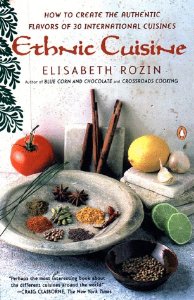“Tomatoes and oregano make it Italian; wine and tarragon make it French. Sour cream makes it Russian; lemon and cinnamon make it Greek. Soy sauce makes it Chinese; garlic makes it good.” Alice May Brock, quoted in The Four-Hour Chef
Cooking may be drudgery that should still be done; cooking can be a lot of fun. Cooking, as skillfully and simply handling good ingredients to turn them into great meals that nourish body and mind and satisfy the palate, is a lesson in the ways we are in this world, there but for the grace of it. And, in looking at the relations between ‘environment’, food, and self, it is an excellent example of the ways in which we can either destroy ourselves and the world, consuming cheap junk, or live sensibly as a part of the world and sustain and improve our health and the pleasure we have.
One major part of the equation is the relationship one finds between products that happened to be(come) available in a certain place and the typical flavors of that part of the world. For a long time already, the idea that relatively few different ingredients made for different such flavor profiles fascinated me immensely.
So, I can’t quite believe it, but with The Four-Hour Chef, I’m really coming around to liking Tim Ferriss – or at least, his work.
Okay, he still doesn’t seem to have had the requisite education for a chilehead. Jalapeños for more spice and habaneros (and miswritten as habañeros at that – thought he knew Spanish?) for the total kick doesn’t quite cut it, considering the range of flavors, aromas and spicinesses that could be found in the world of peppers. Pepper, too, features only as one generic spice, giving short thrift to the number of different varieties there are. In both cases, though, who short of the truly flavor-crazed ones really considers that, anyways? Lamenting that lack is somewhat fun, given how he keeps being adored as if he were the second coming, but it’s nitpicking to the n-th degree.
To even just give cooking something of the importance, in the healthful and pleasurable life and as a lesson for life and learning, that it deserves, though, is an endeavor that can hardly be recommended more highly. Sure, there are more than a lot of books on food and cooking already, but the crowd that Ferriss speaks to is not exactly the kind of person who’d typically swing a spatula (except perhaps for a spanking).
To do so with reference to what is, not just in his words but truly,” a brilliant book that never got the attention it deserved”, is even more recommendable.
 The book in question? Elizabeth Rozin’s Ethnic Cuisine.
The book in question? Elizabeth Rozin’s Ethnic Cuisine.
It is her “flavor principles” that inspired the “flavor combinations” Ferriss presents as a – “perhaps the” – epiphany of how easy it is to just combine a few ingredients to get to a – or even, the – flavor of a certain cuisine, and how exchanging just one or a few of the flavors leads to the aroma of a different area’s cuisine.
Take scallions, lime and chile peppers, and aromatically, you are in Mexico. Switch out the scallions in favor of lime, you have gustatorily traveled to Nepal. Scallions, ginger, cilantro and chile – instant Thai. At least, in Ferriss’ book. Even in Ethnic Cuisine, things are a bit more difficult. There is, after all, a bit more regional variation to cuisines, and there are also such things as cooking techniques (and ingredients) that differ. Still, just pointing to these principles…
I never got quite as far with the idea as I wanted to, but if you ever noticed the pages on different cuisines around the world that also indulge in great use of the chile pepper, and stumbled over the mention of flavor principles there, that book – “Ethnic Cuisine,” or its forebear “The Flavor Principle Cookbook” – is where they are from. In fact, the very awareness of different chile pepper’s (and also pepper’s) different flavors and pungencies in different cuisines stems from this concept.
There is a great variety of chile peppers in Mexico, for example, and they are combined in certain ways for certain dishes. Using a fresh jalapeño instead of dried ancho and pasilla would, to the trained palate that can “see” beyond a little spiciness, make a world of difference in aromas and flavors.
Putting an habanero into Chinese dishes, to switch to the other side of the world, would have to be an absolute no-go. It just doesn’t suit the aromas looked for. In fact, we just recently had that happen here. My wife cooked some chicken in one of the usual Chinese ways, but didn’t quite catch on to how that one red pepper was not a normal one, but an habanero, until we started eating. I had thought I had seen one, but promptly forgotten; she had noticed a somewhat strange aroma, but not paid it enough attention… but as flavor in the dish, well. Let’s just say that there was more for me – and it was not as good as normally.
That is, of course, why I stated so strongly that “there is no chilli.” They aren’t all just simply hot, and therefore interchangeable. They are all different, and all with their proper use – with some overlap, of course, but not the total sameness that is often assumed, with the only difference being in terms of heat levels.
The idea still hasn’t received wider acclaim, but research had recently looked at a related notion, and the results made their way through the media: flavor pairings. We’ll look at that shortly.

Leave a Reply
You must be logged in to post a comment.